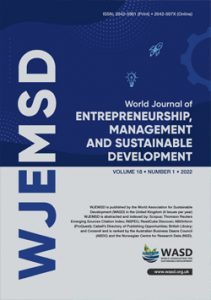Measuring regional competitiveness through agricultural indices of productivity: The Peruvian case, Francisco Coronado, Vincent Charles and Prof. Rocky Dwyer
 Francisco Coronado, Vincent Charles, Prof. Rocky J. Dwyer
Francisco Coronado, Vincent Charles, Prof. Rocky J. Dwyer
CENTRUM Católica Graduate Business School, PUCP, Lima
Peru
Email: fcoronadod@pucp.pe
DOI: 10.1108/WJEMSD-06-2016-0031
Purpose: The purpose of this paper is to incorporate factors that characterize the agricultural activity as productivity indices to compute the agricultural competitiveness of regions in order to rank the regions, and compare the results with those obtained by applying other commonly used social and economic indicators.
Design/methodology/approach: The authors identify regional factors related to the use of water, soil, production, revenues, and rural population, which conform a total of six productivity indices, that the authors then employ to calculate the regional agricultural competitiveness index.
Findings: The agricultural-related indices are informative in supporting the regional ranking related to resources and technology utilization. The results reveal that the coastal regions are the most competitive when compared to the regions located in the highlands and the jungle. Nevertheless, in contrast with other existing competitiveness rankings, the present study identifies the regions with the greatest potential for agriculture.
Research limitations/implications: The authors identify the regions which have a higher potential of development considering the natural resources and agricultural production. The authors hope that this paper can assist regional and national policymakers in their endeavor to improve regional and national competitiveness.
Practical implications: The authors identify the regions with a higher potential of development considering natural resources and agricultural production and the possibilities to improve their competitiveness.
Social implications: The study also bears social implications, given that the rural activities in Peru are carried out by approx. 7 million inhabitants, whose contribution to the gross domestic product (GDP) is as much as 7 percent, making use of about 94 percent of the available water.
Originality/value: The originality of the present paper resides in the attempt to compute a regional competitiveness index by taking agricultural resources as determinant factors. The authors rank the regions based on their agricultural competitiveness.
Keywords: Productivity; Competitiveness index; Economic growth; Regional competitiveness.
Citation: Coronado, F., Charles, V. and Dwyer, R.J. (2017), "Measuring regional competitiveness through agricultural indices of productivity: The Peruvian case", World Journal of Entrepreneurship, Management and Sustainable Development, Vol. 13 No. 2, pp. 78-95. https://doi.org/10.1108/WJEMSD-06-2016-0031

